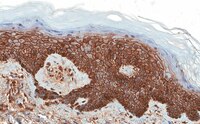The Ser/Thr kinase MAP4K4 drives c-Met-induced motility and invasiveness in a cell-based model of SHH medulloblastoma.
Santhana Kumar, K; Tripolitsioti, D; Ma, M; Grählert, J; Egli, KB; Fiaschetti, G; Shalaby, T; Grotzer, MA; Baumgartner, M
SpringerPlus
4
19
2015
Show Abstract
Medulloblastoma (MB) comprises four molecularly and genetically distinct subgroups of embryonal brain tumors that develop in the cerebellum. MB mostly affects infants and children and is difficult to treat because of frequent dissemination of tumor cells within the leptomeningeal space. A potential promoter of cell dissemination is the c-Met proto-oncogene receptor tyrosine kinase, which is aberrantly expressed in many human tumors including MB. Database analysis showed that c-Met is highly expressed in the sonic hedgehog (SHH) subgroup and in a small subset of Group 3 and Group 4 MB tumors. Using a cell-based three-dimensional cell motility assay combined with live-cell imaging, we investigated whether the c-Met ligand HGF could drive dissemination of MB cells expressing high levels of c-Met, and determined downstream effector mechanisms of this process. We detected variable c-Met expression in different established human MB cell lines, and we found that in lines expressing high c-Met levels, HGF promoted cell dissemination and invasiveness. Specifically, HGF-induced c-Met activation enhanced the capability of the individual cells to migrate in a JNK-dependent manner. Additionally, we identified the Ser/Thr kinase MAP4K4 as a novel driver of c-Met-induced invasive cell dissemination. This increased invasive motility was due to MAP4K4 control of F-actin dynamics in structures required for migration and invasion. Thus, MAP4K4 couples growth factor signaling to actin cytoskeleton regulation in tumor cells, suggesting that MAP4K4 could present a promising novel target to be evaluated for treating growth factor-induced dissemination of MB tumors of different subgroups and of other human cancers. | Western Blotting | 25625039
 |
Osteopontin enhances the expression and activity of MMP-2 via the SDF-1/CXCR4 axis in hepatocellular carcinoma cell lines.
Zhang, R; Pan, X; Huang, Z; Weber, GF; Zhang, G
PloS one
6
e23831
2011
Show Abstract
Osteopontin, SDF-1α, and MMP-2 are important secreted molecules involved in the pathophysiology of human hepatocellular carcinoma (HCC). This study investigates the effect of the SDF-1α/CXCR4 axis on expression and activity of MMP-2 induced by osteopontin.The expression of CXCR4, SDF-1α, MMP-2 and their associated cellular signaling cascades, involving Akt and MAP Kinases, were determined by Western blotting. The activities of MMP-2 and MMP-9 were assayed by gel zymography. The role of the osteopontin receptors integrin α(v)β₃ and CD44v6 was evaluated using neutralizing antibodies. We also established CXCR4-deficient SMMC7721 cell lines by transfection with miRNA-CXCR4 plasmids and determined cell invasion activity in a transwell assay.In comparison with untreated cells, recombinant human osteopontin (rhOPN) up-regulated CXCR4, SDF-1α, and MMP-2 expression about 5-, 4-, and 6-fold on the protein levels through binding to integrin α(v)β₃ and CD44v6 in hepatocellular carcinoma cells (SMMC7721 and HepG2). Inhibition of the SDF-1α/CXCR4 axis down-regulated the rhOPN-induced MMP-2 expression and activity. rhOPN also activated Akt, p38 and JNK. Down-regulation of CXCR4 decreased the rhOPN-induced invasion in SMMC7721 cells.These results indicate that rhOPN up-regulates MMP-2 through the SDF-1α/CXCR4 axis, mediated by binding to integrin α(v)β₃ and CD44v6 and activating the PI-3K/Akt and JNK pathways in HepG2 and SMMC7721 cells. Therefore, the osteopontin-SDF-1α/CXCR4-MMP-2 system may be a new therapeutic target for treating HCC progression. Full Text Article | | 21909361
 |









